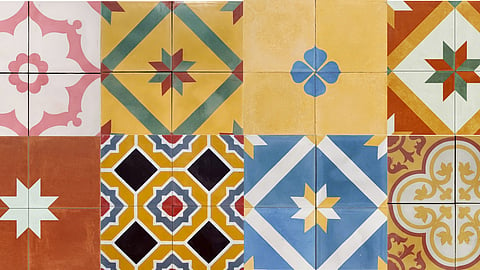
- HOMEGROWN WORLD
- #HGCREATORS
- #HGEXPLORE
- #HGVOICES
- #HGSHOP
- CAREERS
- ABOUT US
- CONTACT US

In the cultural centre of Tamilnadu in Sivaganga district, in the land of the Chettiars, lies Athangudi, a quaint but hot town known for its handcrafted tiles. I was always under the impression that there was only so much tiles could do for a house, until I learnt the colour, labour, and love that Athangudi tiles carry. The tiles are a testimony to rich Chettinad history, when the Chettiars traded extensively during the British Rule, and procured the world’s best raw material to build their mansions. From Italian marble, to Japanese tiles and stained glass, they had it all. But they weren’t walking on the sand of their land. Moreover, repairs of these imported flooring, and tiles were almost impossible due to lack of resources, and local masons did not possess the craft to lay and level it irreplaceably.
At this very moment enters the hero of our story, the Athangudi tiles. Traditionally called Pookal or ‘Flower Tiles’, these are made from sustainable and locally sourced materials like river sand, cement, and naturally occurring oxides. The top soil of this region is the soul of these tiles. Rich in iron oxide, it supports the crafting and stability of the mixture before the tile dries for use. Efforts of tile crafting using the same technique, adopted in other regions with the same soil type have proven to be vile. The soil of Athangudi, mined near the river, filled with minerals and sediments is the only irreplaceable ingredient, in this recipe to a home.
An 8-step-process is what makes the traditional Chettiar palace tiles durable. This begins with placing a piece of glass, shaped according to the tile size on a metal frame, and a stencil placed over this. The colours and cement are mixed separately, and scooped onto each section of the stencil. The metal frame is removed carefully, while the colours spread out evenly. To keep this in place, a thin layer of sand is sprinkled over and the stencil is removed. Over this comes a layer of cement, which is also leveled and pressed for an even finish. After the frame is removed, the tiles are dried for a day, and cured in water for 8-12 days. The cured tiles are sun-dried and shaped for a smooth finish. The most commonly available sizes are 8-inch squares and 10-inch squares with different thicknesses for flooring and skirting.
The tile laying process is also no cake walk. Since the tiles are handmade, there are small and almost unnoticeable differences in both the smoothness and finish of the tiles, which makes laying them a task that only trained Chettinad masons get right.
Being one of the few tiles that don’t require firing in a kiln, Athangudi tiles are also sustainable and get shinier with time.
The Chettinad tiles have a striking resemblance to the Moroccan Zellige tiles in their design, sustainable material and the curing process. It is no secret that the Chettiar community’s trade acumen brought back home many influences in food, culture, and architecture, but this is a 500-year-old tradition that they've truly made their own.
If you enjoyed reading this, here's more from Homegrown:
Redefining Rooftops: A Tiled Kerala Roof Doubles As An Amphitheater
Manduva Logili: Heritage & Culture Through Andhra Pradesh’s Traditional Homes
What Remains Of The Day: Inside The Palatial Chettiar Mansions Of Chettinad
